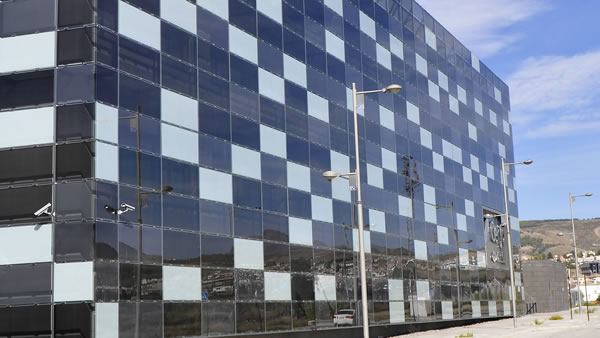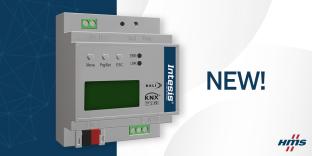 By Jesús Arias García, KNXin.
By Jesús Arias García, KNXin.
Renewable energy is in the news and is gaining support from both the public and private sectors. In a bid to reduce their dependence on fossil-based sources of energy, most developed countries are now investing large amounts of money in wind turbines and solar farms, as well as other innovative technologies such as marine energy.
Large projects however, are only one side of the coin in this new era of energy production. Small renewable energy power plants, generally capable of outputting 1-100kW of power, are being installed all over the place, taking advantage of spare spaces such as roofs or car parks.
From a holistic point of view, this decentralised form of energy production means a whole new ball game in terms of energy transmission and management. Buildings are now playing a new role within the electrical grid, and are not only energy consumers, but energy producers. This duality is known as the ‘grid-tie’ system. It is also possible to find ‘off-grid’ buildings that are completely autonomous.

While these efforts produce clean energy, they will be in vain if it is only energy production that is taken into account. The other important factor is energy management at the point of consumption, so that energy is used in the most efficient way.
The KNX standard fits perfectly within this philosophy, as it helps to avoid energy wastage. After all, the cleanest energy of all, is the energy that is not consumed!
Renewable Energy Production On Site
A typical installation of electricity production based on renewable energy consists of the following:
1) Energy harvesting
Solar panel arrays are the most common method of harvesting energy, but, depending on the climate and location of the building, there are other systems that could be used. These include wind turbines and BIPV (Building Integrated Photovoltaics) – a method that is gaining in importance, since the energy production is part of the building structure itself.

2) Battery array back-up
In case of power outages, a battery array can provide sufficient energy to maintain principal systems for a few hours. In ‘off-grid’ projects, the battery back-up is a must, so that energy is available even when there is no energy production.
3) DC/AC inverter
Electricity generation using solar cells or electromagnetic induction results in direct current (DC), so it must be converted into alternating current (AC). Alternating current has several advantages over direct current in terms of power transmission, which is why all electrical installations are designed to work with alternating current.
4) Grid-tie or off-grid scheme
If the installation uses the grid-tie model, the building is able to draw energy from the grid when on-site production is not enough. Conversely, it can also inject energy into the grid if an excess is produced. The economic penalty/compensation will depend on the legislation in each country.
Alternatively, if a building is completely isolated and depends solely on the energy harvested, it is using an off-grid model.
5) Electrical installation
As with any other building, irrespective of the source of the energy consumed, the building will require an electrical installation infrastructure.

Advantages of Using KNX on Projects with Energy Production On Site
It is clear that a system to integrate, monitor and control all of these subsystems is needed in order to ensure maximum efficiency. KNX technology is ideal for this, and can play an important role by interacting with the different aspects as follows:
1) Energy production
Thanks to energy metering, we can monitor electricity production at any given time, as well as adapt the behaviour of the building to work under the best conditions. Green building certifications, such as LEED (Leadership in Energy and Environmental Design – developed by the U.S. Green Building Council), stress the importance of displaying values, such as energy production or energy consumption, in public areas, thus helping to create awareness amongst the users of the building.
2) Energy back-up
In case of power outage, the building will have a specific amount of energy available. If the capacity of the battery array is monitored, different procedures can be implemented according to the energy remaining. For example, different categories can be set up, so that as the battery capacity drops, the systems or loads can be switched off one by one, from the least important to the most important.
3) Building control
KNX offers multiple solutions regarding systems control. HVAC, lighting, shutters and shading, a wide spectrum of sensors, technical alarms, solenoid valves – the more systems, the better. The idea is to have global solutions that cover as many functions as required in order to save energy or avoid wasting resources.
For example, simple actions such setting the air conditioning system to standby mode while a window is open helps avoid energy wastage. Other more advanced solutions are available, such as ‘free-cooling’. This consists of cooling down the building at night when the temperature outside drops, resulting in less energy being required to cool the building down in the morning when the temperatures increase – something that is typical in Mediterranean countries.
All of these solutions can be implemented using KNX as a decentralised system that looks after the different subsystems ‘on board’.
4) BMS (Building Management System)
KNX is decentralised, which means that no central processor is needed, but it allows the design of complete BMS, integration with SCADA (Supervisory Control And Data Acquisition) and OPC (OLE for Process Control) solutions, etc.
This level of integration is only possible with a standard such as KNX, with multiple solutions for energy metering, energy saving, control over electrical devices, gateways to HVAC systems, and management based on OPC servers or remote management.

KNX Standard Technology – the Key to Energy Management
KNX technology is a powerful tool that system integrators use in order to deliver high-quality projects in terms of building automation. The possible solutions are only limited by the systems integrator’s imagination, while the profusion of KNX manufacturers (more than 300 and growing) enriches the choices available. With more and more niche products that cover almost any aspect within the building, a reliable network of standard-compliant devices can be employed to work towards the same goal: energy efficiency.
Conclusion
It is now almost unimaginable that a new building would be designed without considering energy management as a proactive way of decreasing the building’s energy consumption and, therefore, bills and CO2 emissions.
Green building certifications, continuing price increases in energy and increasing environmental awareness will boost the demand for energy management systems in buildings and homes, where renewable energy is produced and managed locally.
The Smart City is a concept that requires these kinds of solutions, where clusters of energy production and consumption are integrated, and standards, such as KNX, are an effective and reliable means of achieving energy efficiency.
Jesús Arias García is a freelance Engineering Consultant for KNXin, a consultant engineering firm specialising in KNX technology and green buildings. His co-authored book ‘KNX for LEED‘ is available through the KNX Online Shop.














